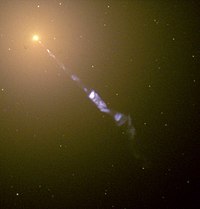
Photo from wikipedia
The Galactic transient black hole candidate H 1743--322 exhibited a long duration outburst in 2003 after more than two and a half decades of inactivity. The 2003 event was extensively… Click to show full abstract
The Galactic transient black hole candidate H 1743--322 exhibited a long duration outburst in 2003 after more than two and a half decades of inactivity. The 2003 event was extensively studied in multi-wavelength bands by many groups. The striking feature is that the total energy released is extremely high as compared to that in tens of outbursts which followed. In this paper, we look at this event and study both the spectral and temporal properties of the source using two component advective flow (TCAF) paradigm. We extract accretion flow parameters for each observation from spectral properties of the decay phase and determine the mass of the black hole. We computed the energy released during all the known outbursts since 2003 and showed that on an average, the energy release in an outburst is proportional to the duration of the quiescent state just prior to it, with the exception of the 2004 outburst. A constant rate of supply of matter from the companion cannot explain the energy release in 2004 outburst. However, if the energy release of 2003 is incomplete and the leftover is released in 2004, then the companion's rate of matter supply can be constant since 1977 till date. We believe that erratic behaviour of viscosity at the accumulation radius $X_p$ of matter as well as location the $X_p$ itself, rather than the random variation of mass transfer rate from the companion, could be responsible for non-uniformity in outburst pattern. We discuss several factors on which the waiting time and duration of the next outburst could depend.
Journal Title: Advances in Space Research
Year Published: 2019
Link to full text (if available)
Share on Social Media: Sign Up to like & get
recommendations!